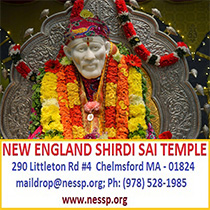Contribute
| Lokvani Talks To Amita Chopra |
Nirmala Garimella
12/03/2014
(This article is sponsored by New England Shirdi Sai Temple)
Amita Chopra was born in New Delhi, India. She attended the All India Institute of Medical Sciences and completed her Pediatric training in Boston. She was Chief Resident in Pediatrics at Boston City Hospital and then practiced Pediatrics in Greater Boston area and Cambridge for over thirty years. During this time she attended at Massachusetts General Hospital, Boston Children's Hospital, St. Elizabeth's Hospital and several other prominent area hospitals.She served as an Instructor in Pediatrics at Harvard Medical school.
Amita is married to Sanjiv Chopra, MD and is a devoted wife, mother and grandmother. Her passions are meditation, music, golf and travel. She has been teaching Raj Yoga based meditation for many years.
Amita shares with us some of her insights on meditation, the benefits and the science and theory behind its understanding.While we chat she tells me that although the practice of meditation is associated with a sense of peacefulness and physical relaxation, it also provides health, cognitive and psychological benefits that have since been proven by various studies."It is fascinating to see the brain’s nueroplasticity and that, by practicing meditation, we can play an active role in changing the brain and can increase our sense of well-being . For instance, it is proven that the metabolic rate of people in the first three minutes of deep meditation is less than 16% compared to other methods.
The following are just some of the excerpts from the conversation:
On the latest scientific discovery of the God particle, the Higgs field and boson and the state of pure consciousness:
Ancient wisdom and modern scientific discoveries operate on a similar paradigm. The West look at it objectively and the East subjectively. Take for example the recently discovered God principle.Recent discoveries do a lot to enhance the understanding of how "consciousness" can create matter. Particles are just packs of energy and the modern rishi or the scientist say that the entire universe is made up of it. It is a field filled with energy. It gives shape to all that is around us. This sounds familiar to someone who has studied the ancient texts or who has experienced deep meditation. The whole universe is made up of pure consciousness and the Vedic rishis called it the Brahman principle - a state of being where there is no beginning, no end, and no space.
On the various forms of meditation:
People practise many forms like Transcendental meditation, Self realization, mindfulness, etc but the bottom line is the same - It is a way of going into oneself, using this power in our daily activity and looking for a benefit whether it is material or spiritual as long as the end result is rejuventing and refreshing.
Scientific proof that meditation works:
A team led by Harvard-affilitated researchers at Massachusetts General Hospital (MGH) reported the results of their study, the first to document meditation of participants in an eight-week mindfulness meditation program. They found that participants who underwent meditation recorded measurable changes in brain regions associated with memory, sense of self, empathy, and stress.
In another study a Nobel prize winner Elizabeth H. Blackburn, a pioneer in the study of telomeres—the ends of chromosomes, found the results varied in aging and cancerion-produced changes over time in the brain’s gray matter.Women with the highest levels of perceived stress had telomeres shorter on average by the equivalent of at least one decade of additional aging compared to low stress women.
On her own practice:
I have been practising meditation for 3o years now. It is a daily ritual of 20 minutes practise twice a day. The ultimate goal for any one practising meditation is finally finding that individual peace.When I asked her how a person could be inducted into this, her answer was " When the student is ready, the teacher will appear".
A good thought for the busy stressful holiday season for many of us!
You may also access this article through our web-site http://www.lokvani.com/
.jpg)
